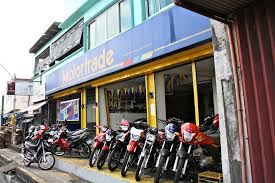
There is no one bike for everyone because people want different things. Motorcycles can be designed for:
- Speed (sports bike)
- Rough terrain (off road bike)
- Touring comfort (touring bike)
- Ease of use (scooter)
- Appearances (chopper)
There are many reasons to pick a bike other than safety, but the fact is that no-one looks cool in a hospital bed. You decide, but here are some safety factors to consider:
- Size and Power: Power to weight ratio
- Width: Keep it narrow, to avoid “clip and flip”.
- Front light: Powerful light to be seen.
- Rear light: Big bright braking light.
- Indicators: Big, stick well out, bendy.
- Horn: As loud as you can get.
- Mirrors: Big enough, stick out, both sides.
- Brakes/Suspension: Get the best you can.
- Seat: Comfy, wide.
- Battery: Holds a big charge.
- Foot pegs: Large enough to stand up on.
- Tires: All weather.
- Luggage: Away to carry extra stuff safely.
Size and Power
Motorcycles can be:
- Small (150cc or less)
- Medium (up to ~400cc)
- Large (is 500 – 900 cc), and
- Very large (1,000+cc).
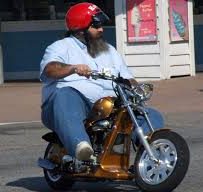
A factor in choosing a bike size is your size. How big are you? Can you pick the bike up if it drops? There are many reasons to drop a bike, mostly harmless, but if you cant pick it up that’s a problem. On a slope, petrol may leak out of the tank cap. Smaller people are less for the bike to carry, so may not need as much power.
Heavier motorcycles tend to be safer as they absorb more in a crash and have better brakes, suspension and lights. They also avoid the small bike “insecurity complex”, so you ride them more sedately. Do people on little motorcycles feel they have to go faster to prove themselves ? I dont know – but sometimes it seems that way. On the other hand, bigger bikes can also mean bigger crashes.
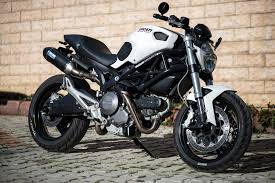
Most important is the power-to-weight ratio (PWR). A heavy bike with a weak engine has a low PWR, not much power and a lot of weight. It is “sluggish” and doing anything takes a while. This can make it safer, especially for beginners. A high PWR is a light bike with a powerful engine – now the slightest accelerator touch gives an immediate response. Such “racing” bikes are dangerous for beginners who dont have the necessary control. There is nothing wrong with a powerful engine on a big frame with good brakes, but put a powerful engine on a light bike with weak brakes and you get a death trap.
Width
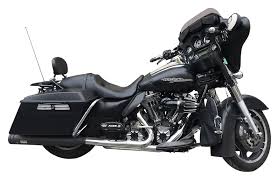
One of the things I always consider is how wide the motorcycle is. A “fatter” bike is less maneuverable and so less safe. It doesn’t take much to tip a bike, as only balance keeps you up. So you don’t want things sticking out the side that can catch and drag you down. This is why most indicators are bendable. Note that a big bike need not be “fat”. In an emergency, you may have to swerve to avoid the car or truck ahead. The fatter the bike, the less maneuverable it is in a tight situation. If the cars ahead stop suddenly, a narrow bike can swerve into a tight gap between two cars. In a such a situation inches can be the difference between coming off or not. For safety reasons, I choose a narrow bike over a fat one, as narrower bikes have more options.
Wheels
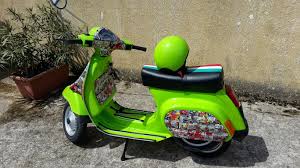
A motorcycle’s stability comes mainly from its wheel’s rotation. The bigger the wheels, the more stability they create when moving. Strangely, while the frame of scooters makes them look more stable, their little wheels mean are less stable in practice, i.e. easier to tip over. If you ride a scooter, be careful of the gravel on the edge of the road, as they tip easily. However scooters are also closer to the ground, and generally don’t go as fast, so riders who fall off often just get back up. Scooters are designed to be easy to ride rather than safe, as you just step through them, and they have an automatic clutch.
Height
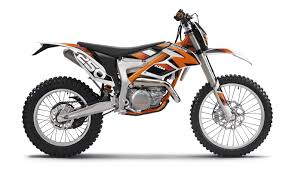
Every bike has a center of gravity (COG) and ground clearance. A high COG makes the bike easier to tip but low COG usually means poor ground clearance. Poor ground clearance means that when you ride over a bump or kerb you hear a “clunk” as the bike scrapes the ground, and the jolt can throw you off. Off road bikes have a high ground clearance to avoid this. Touring bikes have a low COG, as it is assumed they will always be on flat highways. For safety I choose a low COG bike that also has reasonable ground clearance.
Balance

The bike COG should be mid-way between the front and back wheels, to give both wheels traction. So when you apply both brakes, both wheels have stopping power. When you sit on the bike, your center of gravity should sit over the bike’s COG. You can see in the picture that on an easy-rider bike the weight of the rider is too far back. This means the rear wheel has good traction but the front wheel is “light”. So when cornering the handling is bad, because you need front wheel traction to guide the bike round the corner. “Easy rider” bikes look cool but aren’t safe from a handling point of view. Conversely if you sit too far forward, as in badly designed sports bikes, a sudden stop can lift up the back and put you over the handlebars, which is not good. I prefer a bike where my weight is pretty much in the middle between the wheels. This balances the weight so you and the bike as one, in a stable combination.
Headlights
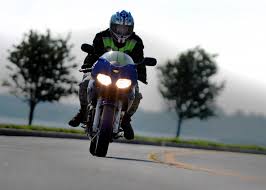
Your headlights make you visible, so others see you and don’t crash into you. So look for big, bright lights. Tiny lights make you hard to see, especially at night. When drivers hit motor-cycle riders, the most common comment is: “I didn’t see him ”. So get a powerful headlight, then they will see you coming. One advantage of bigger bikes is they tend to have bigger batteries that allow bigger headlights. Also check the high beam throws a good extra surge of light that gets attention. The rear light is even more important than the front light, so people don’t hit you from behind. Check the rear light is big, bright and red, not just a designer afterthought. When you touch the brakes, it should glow extra bright.
Indicators
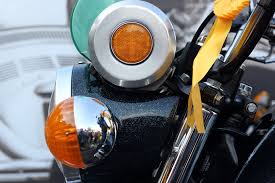
Your indicators tell others you are turning. Some bikes have tiny dot indicators on tiny stalks, that faintly flicker when you try them. These bikes are clearly not built with safety in mind, so dont choose such a bike. Indicators should be large and noticeable, because it is very important that other road users see and know when you are turning. They should stick well out from the side of the bike, and be visible. Check they are bendy not rigid, so if swiped they don’t pull the bike down.
Horn
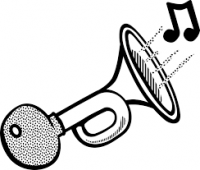
Your horn is a quick way tell other drivers “I am here!” It should be as loud as possible. When a car starts to move into your lane as you pass it, a horn is the best and quickest response. Horns are also useful for warning wandering pedestrians and wavering bicyclists. A tiny horn on a big bike is a sign the designers dont care about safety. What other corners have they cut? Avoid big bikes with baby horns.
Brakes and suspension
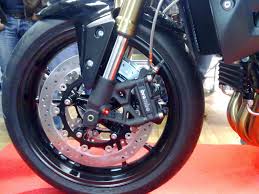
Brakes and suspension work together to stop you in an emergency. Good front and back disc brakes give stopping power, and a good suspension absorbs the shock of stopping. Without suspension, the sudden shock of stopping could throw you off the motorcycle. If you hit a sudden bump, or stop suddenly, you will find out if the bike has good suspension. Rocking the bike can give you a feel for its suspension, but to really evaluate brakes and suspension, read the specs.
Battery
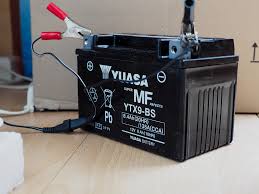
When you buy a bike, you don’t know how good the battery is. Often the factory battery is not the best, for cost reasons. I usually replace it with the best battery I can get. Why? Not all batteries are borne equal. Some hold charge better than others. If your battery fails the bike wont start, so it also fails. This usually happens at the worst possible time (like at traffic lights). You need a good battery if you:
- Ride in traffic with lots of starts and stop.
- Spend time idling in a toll lines (with your headlight on).
- Have a big bike (starting a big bike takes more power).
- Have an older bike that needs two or three tries to start.
If you press the ignition and the engine slowly turns then dies, you need a better battery. Get the best battery you can afford – you wont regret it!
Seat
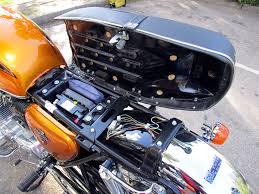
The seat supports your backside, which supports your body, which controls the bike. You realize how important the seat is when you go on a long trip. Body discomforts (like an itch, ache or soreness) are the sort of distractions that cause accidents. Comfort helps safety, and a good seat avoids discomfort. Its shape should fit your shape. A tiny or narrow seat won’t do (unless you have a tiny or narrow backside). Custom shaped seats are nice, but they hold you in a fixed position. I prefer a wide flat seat, so I can move backwards or forwards to adjust my riding position. This is important if you are a different size from normal, which I am. If the seat lifts up for storage, that’s good too.
Foot pegs
Foot pegs keep your feet from hitting the ground and touching the hot exhausts, so make sure they are not too small. Sometimes you want to stand up on a bike, so the foot pegs must give a solid platform to stand. Make sure the foot pedal is “full-foot”, not a little half-wide knob, that your foot can easily slip off.
Mirrors

Your mirrors must be big enough, and be on both sides. They must extend out far enough to give a clear view behind. You have to sit on the bike to check this, as it depends on your size. If your arm blocks half the mirror, that’s still ok, as you can pull your arm in when you view the rear mirror. Mirrors help you see behind, like an extra pair of eyes. I prefer larger mirrors that give a clear back view, not tiny little cheap ones. Never buy a bike without mirrors – they are essential! Getting a good set of mirrors needn’t cost much, and they are easy to fit. When buying a bike, ask the dealer for better mirrors for safety reasons and they may be thrown in for free.
Fairings and windscreens
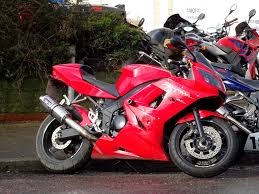
A motorcycle fairing is a shell over the motorcycle frame to reduce air drag. Some people like them and others dont. Racing bikes often have fairings because they reduce wind drag at high speeds, making the bike faster. But while a fairing works for front winds, for side winds they can act more like a sail. When I cross the Auckland harbor bridge for example, there are often side gusts that push the bike about in a scary way. In an open bike the wind mainly flows through the bike, but a fairing presents a flat surface for the wind to push against. I prefer a “naked” bike with no fairing because it is more stable in side winds, and maximizing speed is not my priority. The same goes for windscreens that pretend to protect you from the elements when rally that is the job of other gear. A windscreen on a bike seems to me more symbolic than functional.
Tires
There are many types of tires, even snow tires, but in general there are two main types:
- Fine weather tires are hard, to minimize friction and increase speed.
- Wet weather tires are softer to give more friction and better stopping in wet conditions.

A wet weather tire will “grip” the road better in the rain when a fine weather tire will slip, but for the same reason are slower and wear out quicker. Fine weather tires go faster in fine weather but slip more in wet weather. To go really fast, hard high-speed tires are best. For general safe riding, always choose tires with some wet weather capability. So called all-weather tires aim to give good fine weather performance but also work in the wet. They can be expensive, but are worth it. Get the best all round tires you can afford, because on a bike everything is riding on them. Since you only have two tires, make them good ones. When you buy a bike, have a mechanic check the tires are not cheap fine weather hard tires. If they are, change them!
So there it is! Now you know my safety factors to look for, you can choose what you want. Note if you buy from a dealer, they might swap-out things you dont like, such as tiny mirrors, worn tires or weak battery for better ones, just to sell you the bike. They might also be willing to give a good price for fitting a luggage option like a pack rack, and give reduced prices on other gear. This gives you a total $ all-up price to compare with other sellers.